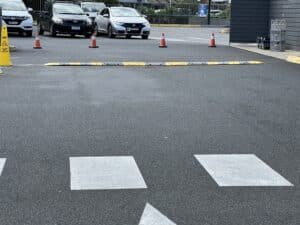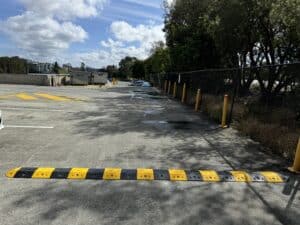

Speed humps are not merely traffic-calming devices; they are powerful tools for enhancing road safety. When strategically placed, speed humps serve as physical and visual reminders to drivers, compelling them to reduce speed and exercise caution, especially in areas where safety is paramount. Speed Humps can reduce accidents, improve pedestrian safety, and create safer, more responsible driving habits on our roads.
In today’s fast-paced world, road safety remains a paramount concern for governments, communities, and individuals. The consequences of accidents and unsafe road conditions are far-reaching and impactful, making it imperative to prioritize safety on our roads. Speed Humps are of critical importance to road safety in modern society. This is backed by statistics and real-life examples that highlight the need for enhanced safety measures. Speed humps play a vital role in achieving our road safety goals, making our streets safer for all.
Significance of Road Safety in Modern Society
Preserving Lives: The most significant aspect of road safety is the preservation of human lives. Each year, countless lives are lost due to road accidents, making it one of the leading causes of preventable deaths. Road safety measures are essential to reduce this toll and ensure that individuals return home safely to their loved ones.
Preventing Injuries: Beyond fatalities, road accidents also result in a multitude of injuries, some of which can have long-lasting or permanent effects. Road safety measures aim to minimize injuries and the associated physical, emotional, and financial burdens.
Economic Impact: Road accidents place a substantial economic burden on society. The costs of medical care, property damage, legal proceedings, and lost productivity are staggering. Road safety measures are not just about saving lives; they are also about preserving resources and reducing financial strain.
Quality of Life: Safe roads contribute to an improved quality of life. People can commute with peace of mind, and communities thrive when they are not marred by the constant fear of accidents. A safe road environment fosters a sense of security and well-being.
The Role of Speed Humps in Achieving Road Safety Goals
Speed Control: One of the primary roles of speed humps is to control vehicle speeds. Speeding is a leading cause of accidents, and speed humps are instrumental in encouraging drivers to slow down, especially in critical areas like school zones or residential neighbourhoods.
Pedestrian Safety: Speed humps play a crucial role in enhancing pedestrian safety. They make crosswalks safer by forcing drivers to reduce speed, giving pedestrians a better chance to cross the road safely.
Traffic Calming: In areas with high traffic volumes, speed humps serve as effective traffic calming devices. They reduce the overall speed of traffic, creating a safer and more controlled environment for all road users.
Creating Awareness: Speed humps are not just physical obstacles; they are visual cues that alert drivers to be cautious. Their presence reminds drivers of the need to exercise care and comply with speed limits.
Road safety is a critical concern in modern society due to the loss of life, injuries, economic costs, and the impact on our quality of life. Speed humps, as proven tools in achieving road safety goals, help control speed, protect pedestrians, and contribute to safer and more responsible driving habits, making our roads safer for everyone.
Speed humps, although often seen as simple road features, play a complex and crucial role in ensuring road safety and responsible driving behaviour.
What Are Speed Humps, and How Do They Function?
Speed humps, also known as road humps or traffic calming humps, are designed to reduce vehicle speeds in specific areas. They serve several functions:
Speed Reduction: Speed humps are strategically placed to compel drivers to slow down. As vehicles approach a speed hump, the vertical deflection of the road surface forces them to reduce speed. This is especially crucial in areas where speeding poses a significant risk, such as school zones or residential neighbourhoods.
Enhancing Safety: Speed humps are installed to enhance safety for all road users. By reducing speeds, they minimize the severity of accidents and the risk of collisions, making roads safer for pedestrians, cyclists, and other drivers.
Traffic Calming: In locations with high traffic volumes, speed humps act as effective traffic calming measures. They create a more controlled and orderly flow of traffic by encouraging drivers to maintain appropriate speeds.
Different Types and Designs of Speed Humps
Speed humps come in various types and designs, each catering to specific road safety and traffic management needs:
Traditional Speed Humps: These are the most common type and have a rounded shape. Traditional speed humps offer a gradual elevation and are designed to slow vehicles without causing discomfort to passengers.
Square-Edged or Flat Top Speed Humps: These humps have a more abrupt profile with square edges. They are effective in reducing speeds but may be less comfortable for passengers in vehicles.
Speed Cushions: Speed cushions are wider than traditional speed humps and are designed to accommodate larger vehicles, such as emergency vehicles and buses. They have gaps that allow these larger vehicles to pass without discomfort, while still slowing down other traffic.
Speed Humps and Their Impact on Driver Behavior
The design and placement of speed humps are grounded in science and psychology, with the primary goal of influencing driver behaviour:
Psychological Impact: Speed humps act as visual cues, signalling to drivers that they are entering a controlled area. The presence of these features encourages drivers to
Improved Driver Compliance: Drivers encounter speed humps regularly, leading to increased awareness and compliance with speed limits. This helps create safer road environments and promotes responsible driving habits.
Speed humps are more than mere bumps in the road; they are engineered solutions designed to enhance road safety.
Accidents on our roads can have life-altering consequences.
Reducing Accidents through Strategic Placement
Speed Reduction: The primary function of speed humps is to reduce vehicle speeds. Strategic placement in areas with a history of accidents or high accident potential compels drivers to slow down. Lower speeds significantly decrease the likelihood of accidents, especially in areas where pedestrians or cyclists are prevalent.
Enhanced Visibility: Speed humps enhance visibility at pedestrian crossings and intersections. By forcing vehicles to slow down as they approach these critical areas, speed humps offer pedestrians and other road users a safer opportunity to navigate through traffic.
Controlled Traffic Flow: In areas with erratic or aggressive traffic patterns, speed humps help control the flow of vehicles. This controlled traffic flow minimizes the chances of sudden stops or collisions and provides drivers with a predictable and orderly road environment.
Real-Life Examples
School Zones: Speed humps installed near schools have consistently proven effective in reducing accidents. Children are often unpredictable in their movements, and speed humps create safer conditions by lowering vehicle speeds. Real-life statistics show a marked decrease in accidents in these areas.
Residential Neighborhoods: Residential streets benefit from speed humps, which deter speeding and promote a safer environment for residents. Case studies from various neighbourhoods demonstrate a reduction in accidents and the severity of collisions.
Retail Areas: Speed humps placed near retail areas and shopping centres contribute to safer pedestrian environments. The presence of these humps reduces the chances of accidents, particularly in crowded parking lots and areas with high pedestrian traffic.
Mechanisms of Speed Humps Promoting Safety
Forced Speed Reduction: Speed humps physically force drivers to reduce speed. This reduction is critical in accident-prone areas where higher speeds can lead to severe collisions.
Driver Alertness: The presence of speed humps serves as a visual and physical reminder for drivers to be alert and cautious. This increased driver alertness results in safer road conditions.
Consistency: Speed humps create consistent and uniform traffic conditions. When drivers encounter speed humps regularly, they become accustomed to slowing down, resulting in a more predictable traffic flow and fewer accidents.
The strategic placement of speed humps is a proven method for reducing accidents on our roads. Speed Humps are effective in various settings, from school zones to residential neighbourhoods and retail areas.
Crosswalks, school zones, and residential areas should be sanctuaries where walkers, especially children, can move without fear. These areas are of vital importance to pedestrian safety in these areas and speed humps play a crucial role in creating safer environments. Speed humps contribute to the protection of pedestrians and ensure that our streets are secure and welcoming for those on foot.
Importance of Pedestrian Safety in Critical Areas
Crosswalks: Crosswalks are designed to provide pedestrians with safe passage across roads. Ensuring the safety of those using crosswalks is paramount, and speed humps near these areas are a key component of achieving this goal.
School Zones: The presence of children in school zones makes pedestrian safety of utmost importance. Speed humps in these areas encourage responsible driving and protect young pedestrians as they journey to and from school.
Residential Areas: Residential neighbourhoods should be safe havens for residents, including walkers. Speed humps promote responsible driving and enhance the security of those living in these communities.
Contributing to Safer Pedestrian Environments
Speed Control: One of the primary ways speed humps enhance pedestrian safety is by controlling vehicle speeds. As drivers approach these humps near crosswalks or in residential areas, they are compelled to reduce speed. This ensures that pedestrians can cross roads with less risk of high-speed accidents.
Heightened Visibility: Speed humps serve to enhance the visibility of crosswalks and pedestrian crossings. By forcing drivers to slow down and pay attention, these road features make it easier for pedestrians to cross safely.
Deterrence of Speeding: The mere presence of speed humps acts as a deterrent to speeding, especially in school zones and residential areas. Drivers are less likely to engage in reckless behaviours when they know that speed humps are in place.
Impact on Pedestrian Safety
Accident Reduction: The installation of speed humps leads to a significant reduction in pedestrian accidents. Speed humps work to prevent accidents and protect the most vulnerable road users.
Injury Severity Reduction: Even in cases where accidents do occur, the severity of injuries is reduced due to the lower speeds that result from speed humps. This means that pedestrians are more likely to survive and recover from accidents.
Safer School Zones: School zones equipped with speed humps report fewer accidents involving children. Speed humps contribute to safer environments for students walking to and from school.
Pedestrian safety near crosswalks, schools, and residential areas is a matter of paramount importance. Speed humps are invaluable tools in creating safer environments for pedestrians. They control speeds, enhance visibility, and deter speeding, all of which contribute to reducing pedestrian accidents and injuries.
Responsible driving is a cornerstone of road safety, and it’s a goal that communities and authorities strive to achieve. Speed humps promote responsible driving and encourage slower and more cautious driving behaviours. They effectively deter reckless driving, ultimately contributing to the creation of a culture of responsible driving on our roads.
How Speed Humps Encourage Responsible and Slower Driving
Forced Speed Reduction: One of the primary ways speed humps promote responsible driving is by forcing vehicles to reduce speed. As drivers approach a speed hump, the vertical deflection compels them to slow down. This reduction in speed ensures that drivers are travelling at safer, more controlled velocities.
controlled velocities.
Visual Cues: Speed humps serve as visual cues to drivers, signalling the need for caution and slower speeds. The very presence of a speed hump reminds drivers of their responsibility to adhere to speed limits and exercise care while on the road.
Improved Road Behavior: Drivers encounter speed humps regularly in various settings, which reinforces the habit of responsible driving. This repetition helps create a consistent and predictable road environment where responsible driving behaviours become the norm.
Deterring Reckless Driving Behaviors
Discouraging Speeding: Speeding is a common form of reckless driving that poses a significant risk to road safety. Speed humps are designed to make speeding uncomfortable and impractical, effectively discouraging this dangerous behaviour.
Reducing Aggressive Driving: Aggressive driving behaviours, such as tailgating and sudden lane changes, are deterred by the presence of speed humps. Drivers are less likely to engage in these behaviours when they encounter speed humps that enforce slower speeds and a more controlled traffic flow.
Promoting Safe Passing: Speed humps encourage safe passing of other vehicles and pedestrians. Drivers learn to navigate speed humps responsibly, ensuring that they provide adequate space and time for others on the road.
Creating a Culture of Responsible Driving
Safety Awareness: Speed humps contribute to safety awareness among drivers. They act as tangible reminders of the need for responsible driving, reinforcing the importance of road safety in our communities.
Community Engagement: Speed humps engage the community in the promotion of responsible driving. Residents and authorities often collaborate to identify locations where speed humps are needed, fostering a sense of collective responsibility for road safety.
Reduced Risk-Taking: The consistent use of speed humps leads to reduced risk-taking behaviours among drivers. The expectation of encountering speed humps encourages responsible driving habits.
Speed humps play a pivotal role in promoting responsible driving on our roads. They encourage drivers to slow down, provide visual cues for caution, and deter reckless driving behaviours. By creating a culture of responsible driving, speed humps contribute to safer and more orderly road environments.
Speed humps are powerful tools for enhancing road safety, but their effectiveness hinges on careful consideration and precise installation. Below are critical factors to consider when installing speed humps. Whether you’re a traffic engineer, community planner, or a concerned citizen, this guide covers selecting the right type, optimal placement, the significance of local regulations, and essential tips for effective installation and maintenance.
Selecting the Right Type of Speed Hump
Consider Road Characteristics: The type of road and its typical traffic flow should influence your choice of speed hump. For busy roads, speed cushions or traditional speed humps may be suitable.
Accommodate All Vehicles: Ensure that the chosen speed hump design accommodates all vehicles that use the road. For areas with emergency services or public transportation, speed cushions are designed to allow the safe passage of larger vehicles.
Address Specific Needs: Different situations may require specific speed hump designs. For instance, school zones may benefit from rounded speed humps, while areas with unique traffic patterns may need square-edged or Flat Top Speed humps.
Optimal Placement of Speed Humps
Identify Accident-Prone Areas: Begin by identifying areas with a history of accidents or a high potential for them. This is often the most critical factor in determining the need for speed humps.
Prioritize High-Risk Zones: Focus on pedestrian-heavy zones, school areas, and residential neighbourhoods. Speed humps should be placed where they will have the most significant impact on road safety.
Collaborate with Stakeholders: Engage with local communities, residents, and businesses to identify the most pressing areas for speed hump installation. Their insights can be invaluable in the decision-making process.
Importance of Compliance with Local Regulations
Familiarize Yourself with Regulations: Before installing speed humps, it’s crucial to understand and comply with local regulations, ordinances, and guidelines. Each area may have specific requirements, such as height limits, spacing, and design standards.
Secure Necessary Approvals: Depending on local regulations, you may need to obtain approvals from local authorities or city councils. Ensure that all necessary permissions are in place before proceeding with installation.
Tips for Effective Installation and Maintenance
Professional Installation: Speed humps should be installed by trained professionals who understand the nuances of their placement. Proper installation ensures their effectiveness and longevity.
Regular Maintenance: Schedule routine maintenance to inspect and repair speed humps. Damaged or deteriorating humps may not function correctly and can pose safety hazards.
Signage and Markings: Ensure that speed humps are well-marked with appropriate signage and road markings to alert drivers to their presence.
Public Awareness: Educate the public about the purpose and importance of speed humps. Public awareness can lead to better compliance and safer roads.
Installing speed humps is a complex process that involves selecting the right type, optimizing placement, complying with local regulations, and ensuring effective installation and maintenance. By considering these factors, we can work together to create safer roads that benefit all road users.
In our journey through the world of speed humps, we’ve explored their significance, their role in enhancing road safety, and the factors to consider when installing them.
Key Points To Note:
Understanding Speed Humps: These road features are not mere bumps in the road but sophisticated tools designed to enhance road safety.
Importance of Road Safety: The importance of road safety cannot be overstated. Speed humps play a pivotal role in achieving road safety goals by reducing accidents, creating controlled traffic flows, and enhancing pedestrian safety.
Promoting Responsible Driving: Speed humps encourage responsible and slower driving behaviours. They deter reckless driving actions, and their consistent use helps establish a culture of responsible driving.
Factors to Consider When Installing Speed Humps: Selecting the right type, optimal placement, compliance with local regulations, and effective installation and maintenance are key factors to ensure the success of speed hump implementations.
The Road to Safer and Responsible Driving
Effective speed humps are not just road features; they are guardians of road safety. They compel drivers to slow down, enhance visibility at critical points like crosswalks, and establish a culture of responsible driving in our communities. These measures are crucial in creating safer environments for pedestrians, cyclists, and all road users. Responsible driving is not just a responsibility; it’s a commitment to ensuring that our roads are safe and welcoming for everyone.
Consider Speed Humps Australia for Your Road Safety Solutions
At Speed Hump Australia, we are dedicated to enhancing road safety through innovative and effective solutions. Our commitment to creating safer roads, our comprehensive understanding of the science and psychology behind speed humps, and our track record of successful installations make us your ideal partner in road safety.
Whether you’re looking to improve safety in school zones, transform residential neighbourhoods, or create secure business districts, Speed Humps Australia offers tailored solutions that address your unique needs. Join us in the pursuit of safer roads and a brighter future for all road users.
The road to safer and responsible driving is one we all share, and Speed Hump Australia is here to lead the way.
Get in touch with us today to request a quote or discuss how we can help with providing a tailored solution to your unique project requirements.




For 10 years, our focus has been on one thing: to provide one style of product and to do it well.
Our wheel stops, speed humps and rumble bars meet Australian Standards, don’t fade, and we’ve never needed to replace one.

For 10 years, our focus has been on one thing: to provide one style of product and to do it well.
Our wheel stops, speed humps and rumble bars meet Australian Standards, don’t fade, and we’ve never needed to replace one.